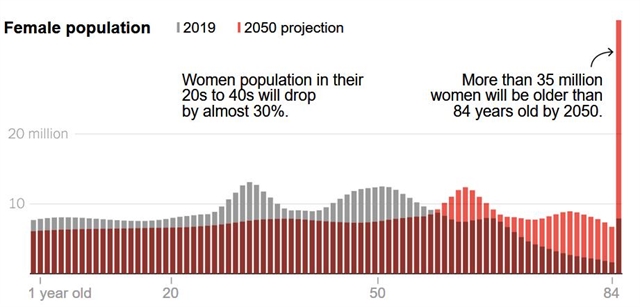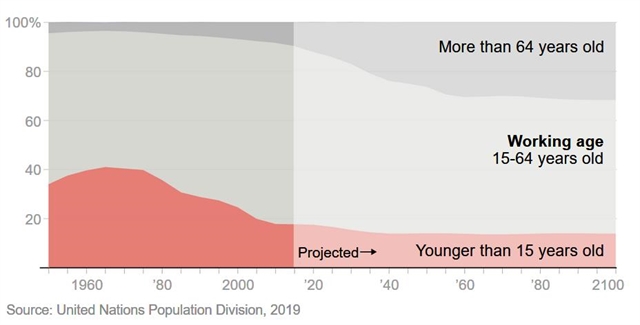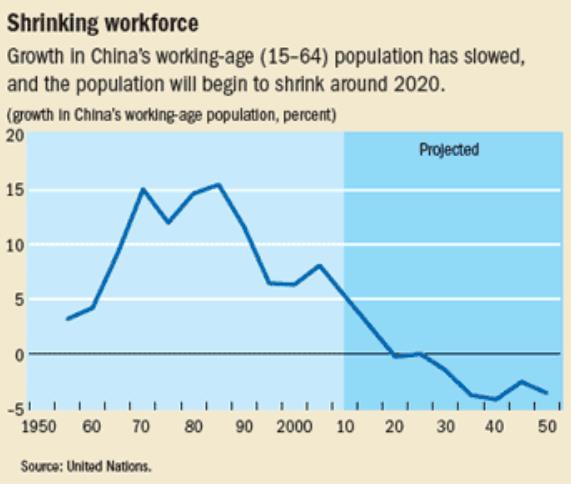 World
World

Sahil Mishra*
China’s economic bubble that saw extraordinary growth in the past few decades is set to burst. The Asian giant faces a “timebomb” of ageing population as the number of young adults is plummeting, thanks to strict birth control policies especially the 1979’s One Child Policy (OCP). Recognising the alarming demographic trend that would have a multi-dimensional negative impact, China ended the OCP and permitted two children in 2016. However, it did not work. According to the China Bureau of Statistics, the total number of births per year fell consistently for three years in a row—from 17.9 million in 2016 to 14.6 million in 2019.

|
The state-run think tank in Beijing, the Chinese Academy of Social Sciences (CASS), has warned that if the fertility rate in China remains at the current level of about 1.6, the country’s population could start to shrink by 2027, and may further plummet to the 1990 level of 1.172 billion people by 2065. There are reasons for it. Despite the government’s encouragement, Chinese women cannot produce more children as most of them were born when the “one child” policy was in force and now are reaching or have already passed their peak fertility age.

|
To make things worse, the number of marriages is also plummeting with every passing year. About 4.3 million couples had registered their marriages with the Ministry of Civil Affairs in the first quarter of 2013. However, the number has reduced to just 3 million during the corresponding period in 2018. According to the United Nations, China is ageing more rapidly than any other major country in the world, which could see the country’s dependency ratio for retirees rise as high as 44 per cent by 2050. The shrinking workforce is going to have substantial negative impact on the world’s second largest economy.
Yi Fuxian, an economist at Peking University, feared that the trend would have China’s economic vitality keep waning. The deteriorating demographics would lead to sluggish growth and a shrinking tax base, which will force Chinese government to re-evaluate spending. It may easily threaten economic stimulus programs in times of rising public debt and economic slowdowns. "China is unique: she is getting older before she has got rich," said Wang Dewen, of the World Bank's China social protection team. The ageing population would slow down consumer spending and put heavy burden on the Chinese economy, leaving the government to struggle to pay for the senior citizens, whose number would keep increasing.

|
China’s growth potential would slow down from current 6.5 per cent to 5.5 per cent by 2025, falling further to 4.5 per cent by 2030, which would make the Asian giant’s desire to overtake the US as the world’s biggest economy a bit difficult, analyses JPMorgan. This would certainly affect China’s ambitious Belt Road Initiative (BRI) plan that seeks to expand the country’s economic and military footprints across the globe. The CASS research shows that China's population would drop to 1.36 billion - a fall in the labour force of close to 200 million- by 2050. China economic explosive economic growth so far has been based on the manufacturing sector that was driven by affordable sources of labour. If the labour force keeps shrinking, it would cause wages to go up and thus ultimately hurting China’s global competitive edge in the sector as many trading partners rely heavily on imports from China.

|
According to the International Monetary Fund (IMF), the demographic developments in China portend an imminent transition to a labour-short economy. “The United Nations projects that ageing and declining fertility will result in a smaller working-age (15–64) population in less than a decade. The core group of industrial workers (ages 25–39, born at the start of the restriction of couples to one child) will shrink even faster, and the rapidly ageing population will reverse a more than half-century decline in the dependency ratio—that is, the number of people younger than 15 or older than 64 divided by the working-age population,” the financial institution says in one of its reports.
* Sahil Mishra is a retired Air force officer. He is a National Defense academy alumni and completed his Air force training in Hyderabad getting commissioned as a fighter pilot.




